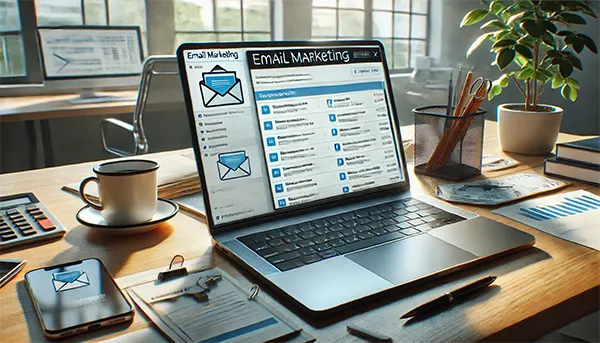
The Role of Personalization in Email Marketing for Conversion Increase
Email marketing has become one of the most effective methods of digital communication, allowing businesses to reach their audience directly. One of the critical elements for success in this field is personalization. Personalizing emails to fit the needs and preferences of individual recipients can significantly improve conversion rates. This strategy helps brands to stand out in crowded inboxes and engage customers on a deeper level, making them feel valued. In this article, we will explore the importance of personalization in email marketing and how it can boost conversions for businesses.
The Role of Personalization in Email Marketing
Email marketing has evolved over the years from generic, one-size-fits-all newsletters to highly targeted, personalized messages. Personalization refers to the practice of tailoring email content based on individual recipient data, such as their preferences, behavior, and demographics. By collecting and analyzing this data, marketers can craft emails that feel more relevant and personal to each recipient, resulting in higher engagement and greater conversion rates.
Research shows that personalized email campaigns can generate up to six times higher transaction rates than non-personalized ones. A personalized approach helps to create a sense of connection between the brand and the customer, making the latter more likely to act on the offer presented. Personalization is no longer just about addressing the customer by their first name – it involves curating content based on their interaction history with the brand.
Furthermore, personalization enables brands to send the right message at the right time. With the help of automation and sophisticated segmentation techniques, businesses can schedule emails to be sent when they are most likely to be opened and acted upon. The more targeted and relevant the email, the greater the chances of turning leads into loyal customers. Let’s delve deeper into how personalization can specifically affect conversions.
The Psychology Behind Email Personalization
The psychology of personalization lies in its ability to make customers feel special and valued. When individuals receive an email that speaks directly to their needs and interests, they are more likely to engage with it. Personalized emails create an emotional connection, making the recipient feel understood and acknowledged by the brand.
One of the psychological triggers at play here is the principle of reciprocity. When a brand sends personalized content that is tailored to a customer’s preferences, the customer feels a sense of indebtedness and is more likely to reciprocate by making a purchase. The concept of familiarity also plays a significant role; the more familiar the content feels to the recipient, the more likely they are to trust the brand and take action.
Additionally, personalized emails make customers feel like the brand is speaking directly to them rather than to a large audience. This creates a feeling of exclusivity, which can drive engagement and, ultimately, conversions. Let’s now look at how businesses can leverage different tools and strategies to effectively implement personalization in their email marketing campaigns.
Tools and Strategies for Personalizing Email Campaigns
To implement effective personalization in email marketing, businesses need the right tools and strategies. Marketing automation software is crucial in gathering and analyzing customer data to create highly targeted campaigns. These tools allow marketers to segment their audience based on various criteria, such as past purchases, browsing behavior, or engagement with previous emails.
Additionally, dynamic content blocks are a powerful feature that allows businesses to change specific elements of an email based on the recipient’s profile. For example, a company can send an email with product recommendations based on what the customer has previously viewed or purchased. This makes the email feel even more personalized and increases the likelihood of conversion.
Timing is another key element in the personalization strategy. By using customer behavior data, businesses can determine the best time to send an email to each recipient. Whether it’s a product reminder or a special offer, sending the right message at the right time can significantly increase open and click-through rates, boosting conversion rates overall.
How to Set Up Personalization in Email Marketing
Setting up personalization involves several steps, but the process can be made efficient with the right tools. The first step is to collect data on your customers. This data could be based on demographics, purchase history, browsing patterns, and engagement with past emails. By understanding your customers’ preferences and behavior, you can start to create customer segments that will receive relevant content.
Once you’ve segmented your audience, you can begin crafting personalized email content. This could involve changing the subject line to include the recipient’s name or suggesting products that are relevant to their past purchases. The more personalized the content, the more likely the recipient will engage with it.
It’s also important to test different variations of personalized emails to see what resonates best with your audience. A/B testing can help determine which personalization strategies yield the best results. By continually optimizing your email campaigns, you can ensure that they remain effective and continue to drive conversions.

Impact of Personalization on Conversion Rates
Personalization plays a significant role in boosting conversion rates. According to various studies, personalized emails have significantly higher open rates, click-through rates, and conversion rates than their generic counterparts. The tailored content increases the chances of the recipient acting on the offer, whether it’s making a purchase, signing up for a newsletter, or clicking on a link.
Personalization also leads to improved customer loyalty. When customers feel valued and understood, they are more likely to make repeat purchases and remain loyal to the brand. A personalized experience can help create long-term relationships between the brand and its customers, which is key to maximizing customer lifetime value.
Incorporating personalization into email marketing strategies not only enhances customer experience but also allows businesses to track customer behavior more effectively. This data can be used to refine future campaigns, making them even more targeted and successful. Let’s take a closer look at how businesses can measure the effectiveness of their personalized campaigns.
Measuring the Effectiveness of Personalization
To determine the success of personalized email campaigns, it’s crucial to measure key performance indicators (KPIs) such as open rates, click-through rates, and conversion rates. By comparing the performance of personalized emails to non-personalized ones, businesses can assess how much personalization is contributing to their success.
It’s also important to track customer retention and lifetime value, as personalization plays a key role in fostering long-term relationships with customers. Tools like customer relationship management (CRM) systems can help businesses gather insights into how personalization affects customer loyalty over time.
Finally, continuous testing and optimization are essential to ensure the personalization strategy remains effective. By analyzing campaign data and adjusting content based on customer feedback and behavior, businesses can improve their email marketing efforts and ensure better conversion rates moving forward.
Popular
-
 Artificial Intelligence in Online Casino M...
Artificial Intelligence in Online Casino M...Artificial intelligence (AI) has transformed how online casinos analyse player behaviour, optimise …
-
 Ethics, Responsible Engagement, and Transp...
Ethics, Responsible Engagement, and Transp...The digital world of 2025 has placed ethics and responsibility at the …
-
 The Future of Copywriting: How Artificial ...
The Future of Copywriting: How Artificial ...In the past few years, the evolution of artificial intelligence has reshaped …
-
 The Future of Search Without Cookies: How ...
The Future of Search Without Cookies: How ...The phase-out of third-party cookies marks one of the most significant changes …
